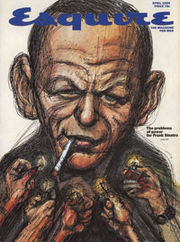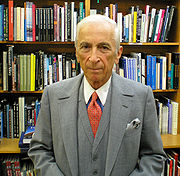
Frank Sinatra Has a Cold
Encyclopedia

Frank Sinatra
Francis Albert "Frank" Sinatra was an American singer and actor.Beginning his musical career in the swing era with Harry James and Tommy Dorsey, Sinatra became an unprecedentedly successful solo artist in the early to mid-1940s, after being signed to Columbia Records in 1943. Being the idol of the...
written by Gay Talese
Gay Talese
Gay Talese is an American author. He wrote for The New York Times in the early 1960s and helped to define literary journalism...
for the April 1966 issue of Esquire
Esquire (magazine)
Esquire is a men's magazine, published in the U.S. by the Hearst Corporation. Founded in 1932, it flourished during the Great Depression under the guidance of founder and editor Arnold Gingrich.-History:...
. The article is one of the most famous pieces of magazine journalism and is often considered not only the greatest profile ever written of Frank Sinatra but one of the greatest celebrity profiles ever written. The profile is one of the seminal works of New Journalism
New Journalism
New Journalism was a style of 1960s and 1970s news writing and journalism which used literary techniques deemed unconventional at the time. The term was codified with its current meaning by Tom Wolfe in a 1973 collection of journalism articles he published as The New Journalism, which included...
and is still widely read, discussed and studied. In the 70th anniversary issue of Esquire in October 2003, the editors declared the piece the "Best Story Esquire Ever Published."
The assignment
Talese had spent the first ten years of his career at The New York TimesThe New York Times
The New York Times is an American daily newspaper founded and continuously published in New York City since 1851. The New York Times has won 106 Pulitzer Prizes, the most of any news organization...
. Talese felt restricted by the limitations of newspaper writing and began searching for jobs with magazines. In 1965, he signed a one-year, six-story contract with Esquire magazine. His first assignment from Esquire editor Harold Hayes
Harold Hayes
Harold Thomas Pace Hayes was a main architect of the New Journalism movement.-Biography:He was born on April 18, 1926 in North Carolina.He was an editor of Esquire magazine from 1963 to 1973...
was to write a profile of Frank Sinatra. It was a difficult assignment; Sinatra had turned down interview requests from Esquire for years.
Sinatra was about to turn 50 and was heavily in the spotlight. Sinatra's relationship with 20-year-old Mia Farrow
Mia Farrow
Mia Farrow is an American actress, singer, humanitarian, and fashion model.Farrow first gained wide acclaim for her role as Allison Mackenzie in the soap opera Peyton Place, and for her subsequent short-lived marriage to Frank Sinatra...
was constantly in the news. A CBS
CBS
CBS Broadcasting Inc. is a major US commercial broadcasting television network, which started as a radio network. The name is derived from the initials of the network's former name, Columbia Broadcasting System. The network is sometimes referred to as the "Eye Network" in reference to the shape of...
television documentary had upset Sinatra, who felt that his life was being pried into and was unhappy about speculation in the documentary about his connection to mafia leaders. He was also worried about his starring role in an upcoming NBC
NBC
The National Broadcasting Company is an American commercial broadcasting television network and former radio network headquartered in the GE Building in New York City's Rockefeller Center with additional major offices near Los Angeles and in Chicago...
show named after his album, A Man and His Music
A Man and His Music
A Man and His Music is a 1965 double album by Frank Sinatra. It provides a brief retrospective of Sinatra's musical career...
, and his various business ventures in real estate, his film company, his record label and an airline. At the time, Sinatra maintained a personal staff of 75.
But Sinatra refused to be interviewed for the profile. Rather than give up,
Talese spent the three months, beginning in November 1965, following Sinatra, observing everything he could and interviewing any members of his entourage who were willing to speak. Esquire paid nearly $5,000 in expenses over the duration of the story. Talese vacillated on whether the story could be finished, but ultimately concluded, in a letter to Harold Hayes that "I may not get the piece we'd hoped for—the real Frank Sinatra but perhaps, by not getting it—and by getting rejected constantly and by seeing his flunkies protecting his flanks—we will be getting close to the truth about the man." Without Talese ever receiving Sinatra's cooperation, the story was published in April 1966.
The profile

Influence on New Journalism
The article was an instant sensation. Journalist Michael KinsleyMichael Kinsley
Michael Kinsley is an American political journalist, commentator, television host, and pundit. Primarily active in print media as both a writer and editor, he also became known to television audiences as a co-host on Crossfire...
has said, "It's hard to imagine a magazine article today having the kind of impact that [this] article and others had in those days in terms of everyone talking about it purely on the basis of the writing and the style."
After Tom Wolfe popularized the term "New Journalism" in his 1973 anthology The New Journalism
The New Journalism
The New Journalism is a 1973 anthology of journalism edited by Tom Wolfe and E. W. Johnson. The book is both a manifesto for a new type of journalism by Wolfe, and a collection of examples of New Journalism by American writers, covering a variety of subjects from the frivolous to the deadly serious...
, Talese's piece became widely studied and imitated. Vanity Fair called it "the greatest literary-nonfiction story of the 20th century."
The piece is often contrasted to modern magazine profiles in which the writers spend little time with their subjects or when writers fabricate elements of their story, such as Jayson Blair
Jayson Blair
Jayson Blair is an American reporter formerly with The New York Times. He resigned from the newspaper in May 2003 in the wake of the discovery of plagiarism and fabrication in his stories. Since 2007 he has worked as a life coach in the field of mental health.-Background:Blair was born in...
, Stephen Glass, or Janet Cooke
Janet Cooke
Janet Leslie Cooke is an American former journalist who became infamous when it was discovered that a Pulitzer Prize–winning story that she had written for The Washington Post had been fabricated.-Early career:...
.
Talese has come to reject the label of "New Journalism" for this reason. Talese told NPR
NPR
NPR, formerly National Public Radio, is a privately and publicly funded non-profit membership media organization that serves as a national syndicator to a network of 900 public radio stations in the United States. NPR was created in 1970, following congressional passage of the Public Broadcasting...
: "The term new journalism became very fashionable on college campuses in the 1970s and some of its practitioners tended to be a little loose with the facts. And that's where I wanted to part company. I came up with the New York Times as a copy boy and later on became a reporter and I so revered the traditions of the Times in being accurate."
The story continues to receive acclaim and is cited by Talese as one of his best works. The story, which continues to be widely read, has been republished in multiple anthologies.
External links
- "Frank Sinatra Has a Cold" in EsquireEsquire (magazine)Esquire is a men's magazine, published in the U.S. by the Hearst Corporation. Founded in 1932, it flourished during the Great Depression under the guidance of founder and editor Arnold Gingrich.-History:...
.

